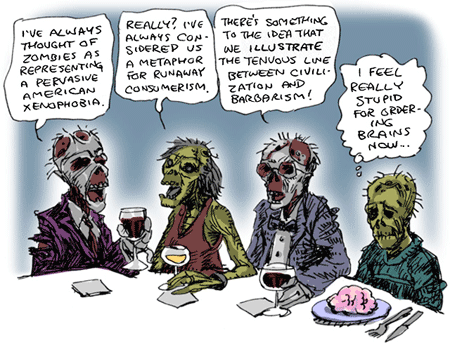Sociología post-apocalíptica

Between the Living and Undead: How Zombie Cinema Reflects the Social Construction of Risk, the Anxious Self, and Disease Pandemic: Robert Wonser y David Boyns, en este artículo, destacan la relación entre las temáticas de las películas de zombis y los problemas centrados en el yo, en la construcción de la identidad y en la ansiedad ante pandemias. Este análisis sociológico comienza observando la película White Zombie (1936) y relacionando sus temas con el miedo a la pérdida de autonomía (miedo que surge por el choque de ideologías del siglo XX), al imperialismo y a la explotación laboral, todos ellos relacionados con las ansiedades de la época. A esta película le suceden otras como I Walked with a Zombie (1943), Night of the Living Dead (1968), Return of the Living Dead (1985), Night of the Living Dead (1990), 28 Days later y Dawn of the Dead (2004), cada una de ellas reflejando determinados miedos o ansiedades relacionadas con el momento de su estreno.
El ensayo también alude al yo del zombi, o más bien a la falta de este. Su naturaleza se repite a lo largo de las obras cinematográficas: un ente que no tiene conciencia de si mismo, deshumanizado, que está fuera del orden social y por tanto eliminarlo es una posibilidad que no está penalizada por la sociedad humana. Es más, al ser competidores por la supervivencia, llega a ser un requisito. Esto tiene ciertas implicaciones morales: ¿y si el zombi puede ser rescatado de su estado? En The Walking Dead (2010) se habla de que el zombi puede ser curado, y por tanto es moralmente reprochable eliminarlo. La diferencia entre que el yo original del zombi pueda ser recuperado o no, o presente algo de su pasada humanidad, supone el dilema moral de la sociedad post-brote.
Los autores profundizan también en el rol del privilegio en la probabilidad de supervivencia del individuo. Elementos como la lejanía de la urbe social, el fácil acceso a recursos vitales, tener una profunda red de contactos personales o el poder aislarse del predador zombi con relativa facilidad ayudan a la supervivencia.
Resumen: The zombie film has become an important component of contemporary popular culture. The sociological nature of the themes addressed by these films reflect prominent social concerns, and lend themselves to sociological analysis as texts themselves. This article examines the zombie film genre, its history, predominant themes, and its illustration of sociological dynamics related to identity, collective behavior, disease, contagion, and the privileges that come from social inequality. Particular attention is placed on what the zombie films, themselves, can tell us about society and how they illustrate sociological principles. First, we examine the origins and history of zombie cinema. Next, we move to a discussion of the central narrative devices around which zombie films are organized. In particular, we focus on two narratives in zombie films: those that emphasize zombie possession; and those that focus on the sociological risks of zombie pandemics. The discussion then moves to an analysis of zombies as selves, and how zombie films express cultural anxieties about selfhood, loss of autonomy, and threats of de-individualization. We then explore the roles of power and privilege in the social epidemiology of zombification, paying particular attention to how those who succumb to zombiedom illustrate the sociological dynamics of health disparities in the real world. Finally, the sociology of infectious disease is used to address how zombiedom correlates with real disease outbreaks, what we know about the social aspects of infectious disease transmission, and the sociology of pandemics.
Tipo Artículo en revista científica
Autor Robert Wonser
Autor David Boyns
Volumen 57
Ejemplar 4
Páginas 628-653
Publicación TSQ The Sociological Quarterly
ISSN 0038-0253
Fecha 2016
Marcas: collective – behavior – disease – identity – inequality – power – privilege – sociology of film